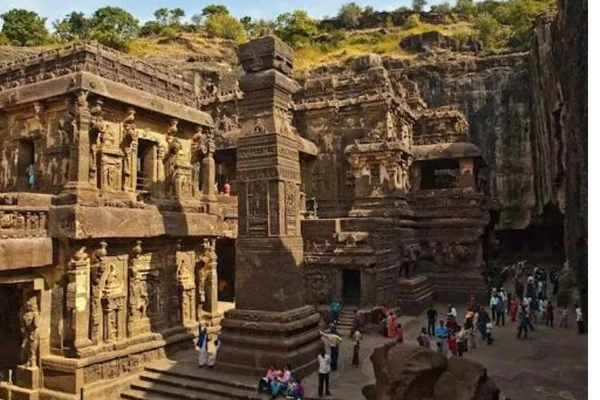The Ministry of Tourism has incorporated the UNESCO World Heritage sites of Ajanta and Ellora caves into the Swadesh Darshan Scheme II, aimed at promoting sustainable tourism and preserving cultural heritage.
About Ajanta and Ellora Caves:
- The Ajanta and Ellora caves are located in the Aurangabad district of Maharashtra.
- Both the caves are designated as a UNESCO World Heritage Site.
Ajanta Caves:
- The Ajanta Caves are 30 rock-cut Buddhist cave monuments that date from the second century BCE to about 480 CE.
- The caves are excavated out of a vertical cliff above the left bank of the river Waghora.
- They were created over two phases: 2nd century BC and 400–650 AD.
- Monks used these serene caves for religious retreats, deepening their spiritual quest.
Types of Caves:
- Vihara: Monasteries for living and prayer, with square halls, small cells, and a central space for prayer.
- Chaitya Griha: Halls dedicated to prayers, with tunnel-like structures and a stupa symbolizing Lord Buddha.
Architecture:
- The caves at Ajanta are known for their Buddhist religious art and comprise monasteries and prayer halls with exquisite sculptures and detailed wall paintings (frescoes).
- The art depicts the life and teachings of Buddha, Jataka tales, and various Buddhist deities.
Abandonment and Rediscovery:
- Local Shift: Abandoned for nearly 300 years due to the local population becoming predominantly Hindu.
- Revival: Revived with the reign of Emperor Harishena of the Vakataka dynasty.
- Rediscovery: John Smith accidentally found the entrance in 1819, bringing attention after nearly 1,000 years.
Ellora Caves:
- The Ellora Caves are located on the Aurangabad-Chalisgaon road, north-northwest of Aurangabad.
- They comprise 34 monasteries and temples, carved into a high basalt cliff, spanning over 2 km.
- They were constructed from the 5th to 10th centuries.
- The caves are locally known as “Verul Leni“.
Architecture:
- The Ellora Caves are divided into three groups – Buddhist Caves (1 to 12), Hindu Caves (13 to 29), and Jain Caves (30 to 34).
- The Kailasa Temple in Cave 16 is particularly notable; it is the largest monolithic structure carved from a single piece of rock and is dedicated to Lord Shiva.
Religious Diversity:
- Devoted to Hinduism, Buddhism, and Jainism.
- Buddhist caves, Hindu caves, and Jain caves built during different periods.
- Buddhist Caves:
- Created between the 5th and 8th centuries.
- Features viharas (monasteries) with living quarters, kitchens, and sleeping quarters.
- Notable cave: Vishwakarma cave, popularly known as the ‘carpenter’s cave.’
- Hindu Caves:
- Constructed between the 6th and 8th centuries.
- Highlight: Kailasha, a multi-storeyed temple complex carved from a single rock.
- Jain Caves:
- Belong to the last phase of Ellora’s construction.
- Smaller in size but adorned with intricate artwork.
- Noteworthy features: Indrasabha, Chota Kailasha, and sculptures of Yakshini and Durga.
About Swadesh Darshan Scheme II:
- The Ministry of Tourism launched the Swadesh Darshan Scheme (SDS) for integrated development of theme based tourist circuits in the country in 2014-15 with the objective to develop tourism infrastructure.
- Ministry of Tourism revamped its Swadesh Darshan scheme as Swadesh Darshan 2.0 (SD2.0) for development of sustainable and responsible tourist destinations.
- It is a 100% centrally funded initiative, but the responsibility for the operation and maintenance (O&M) of the projects sanctioned under the scheme lies with the respective State Government or Union Territory Administration.
- The objective for the scheme envisage increase in private sector investment in tourism & hospitality.
- With the inclusion of Ajanta and Ellora Caves, the Swadesh Darshan Scheme II now encompasses 57 destinations spread across 32 states and Union Territories.
Objectives:
- Local Economic Development: Enhancing the contribution of tourism to local economies by creating jobs, including self-employment opportunities for local communities.
- Private Sector Investment: Increasing private sector investment in the tourism and hospitality sectors for sustained growth and development.
- Cultural and Natural Resource Preservation: Preserving and enhancing local cultural and natural resources stands as a primary objective, ensuring the conservation of India’s rich heritage.
What is a tourist circuit?
- Tourist Circuit is defined as a route having at least three major tourist destinations which are distinct and apart.
- Circuits should have well defined entry and exit points.
- A tourist who enters should get motivated to visit most of the places identified in the circuit.
- A Circuit could be confined to a State or could be a regional circuit covering more than one State/Union Territory.
- These circuits may have one dominant theme and other sub-themes.
- Projects under the scheme shall be under the following identified themes; Eco-tourism, Wildlife, Buddhist, Desert, Spiritual, Ramayana, Krishna, Coastal, Northeast, Rural, Himalayan, Tribal and Heritage.
Other recent tourism initiatives by the government:
- The Ghrishneshwar Temple in the Chhatrapati Sambhajinagar district has been included in the Pilgrimage Rejuvenation and Spiritual Heritage Augmentation Drive (PRASHAD) scheme by the Central government.
- Grishneshwar Jyotirlinga Temple is one of the 12 Jyotirlinga temples and is built in the Hemadpanti architectural style.
- The PRASHAD scheme is a Central Sector Scheme launched by the Ministry of Tourism.
- It aims to develop and identify pilgrimage sites across India to improve the religious tourism experience.
Ref: Source
| UPSC IAS Preparation Resources | |
| Current Affairs Analysis | Topperspedia |
| GS Shots | Simply Explained |
| Daily Flash Cards | Daily Quiz |



